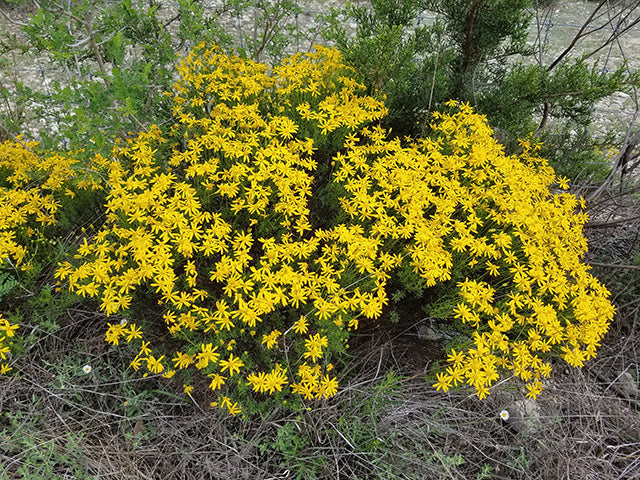Damianita (Chrysactinia mexicana)
Damianita (Chrysactinia mexicana)
Low stock: 2 left
Couldn't load pickup availability
Chrysactinia mexicana A. Gray
Damianita
Asteraceae (Aster Family)
Synonym(s):
USDA Symbol: CHME3
Damianita is a 1-2 ft., bushy, low-growing, aromatic, evergreen shrub with stems rising in a mounded or bouquet form from a woody base. Leaves crowded on the twigs, dark green, up to 3/8 inch long by 1/16 inch or less wide, covered with green to black glandular dots visible under a 10x hand lens. This is a very leafy plant - the narrow, fragrant foliage everywhere except on the 1-3 in. long peduncles. These extend from branch tips and bear a solitary, yellow, composite flower. The flower heads are golden yellow, 1 inch across, commonly with 8 narrow ray flowers, on slender stems at the end of the branches. Fruit very small, 1/8 inch long and with a crown of short bristles visible under a 10x hand lens.
Technically a shrub; used like a flower. Very drought-tolerant.
Plant Characteristics
Duration: Perennial
Habit: Subshrub , Shrub
Leaf Retention: Evergreen
Size Notes: Up to about 2 feet tall.
Fruit: Fruit is a cypsela (pl. cypselae). Though technically incorrect, the fruit is often referred to as an achene.
Bloom Information
Bloom Color: YellowBloom Time: Mar , Apr , May , Jun , Jul , Aug , Sep , Oct , Nov
Distribution
USA: NM , TXNative Distribution: Edwards Plateau & Trans-Pecos in TX, NM & adjacent Mex.
Native Habitat: Found on caliche and limestone outcrops in the southern half of the Hill Country. Well-drained sand, loam, caliche or limestone. Limestone sites in desert plains & mountains
Growing Conditions
Water Use: LowLight Requirement: Sun
Soil Moisture: Dry
Drought Tolerance: High
Cold Tolerant: yes
Soil Description: Igneous, Limestone-based, Sandy, Sandy Loam, Medium Loam, Clay Loam, Clay, Caliche type.
Conditions Comments: Significant drought hardiness and wonderfully aromatic foliage are two features damianita has going for it. Mainly it blooms in spring, then on and off again through summer. Older plants may take on a twisted, gnarled appearance. Technically a shrub; used like a flower. Creates a vivid, yellow carpet when massed. Excellent border plant for flower bed or a ground cover for hillsides or hot exposed areas. Prune lightly after bloom periods to shape plant. Requires excellent drainage.
Benefit
Use Ornamental: Creates a vivid, yellow carpet when massed. Excellent border plant for flower bed or a ground cover for hillsides or hot exposed areas. Showy, Aromatic, AttractiveUse Wildlife: Cover, Nesting site, Nectar-insects
Conspicuous Flowers: yes
Fragrant Flowers: yes
Fragrant Foliage: yes
Deer Resistant: High
Propagation
Description: Sow seed in spring, or take softwood cuttings in summer.Seed Collection: Collect the dry flower heads after the blooming periods and store in paper bags or sealed containers in cool, dry place until spring planting.
Seed Treatment: Sow seed as early as possible, especially in fall.
Commercially Avail: yes
Maintenance: To keep damianita more compact, remove the woody stems from underneath and deadhead or "tip" the tops. Tolerates poor soil.
https://www.wildflower.org/plants/result.php?id_plant=CHME3
Image Information
Photographer: Flaigg, Norman G.County: Murray
State: OK
Accession date: 2003-03-26
Filename: PCD3920_IMG0036.JPG
Slide Index: C32 02-0373
Restrictions: Unrestricted
Collection: Wildflower Center Slide Library
Original Format: 35 MM
Orientation: Landscape
Shot: Flower(s)
Date Taken: 2002
NPIN Image Id: 10226


